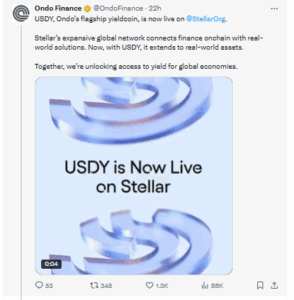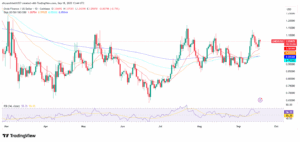Ondo Finance has announced that USDY, its yield-bearing stablecoin, is now available on the Stellar blockchain. The move extends USDY’s reach beyond Ethereum and Solana into Stellar’s payment-focused network, allowing users to hold and transfer a dollar-pegged token that generates yield from U.S. government debt.

USDY was launched by Ondo Finance in 2023 with the aim of addressing a shortcoming in conventional stablecoins. Tokens such as Tether’s USDT and Circle’s USDC track the value of the dollar but do not generate returns. That makes them useful for payments and trading but leaves them idle as savings tools. USDY, in contrast, is backed by short-term U.S. Treasuries and bank demand deposits, which produce regular interest income. This yield is passed on to holders, allowing them to benefit from the safety of dollar stability while also earning returns.
Ondo offers two versions of the product. The first, USDY, gradually rises in price over time as yield accrues. The second, rUSDY, keeps its value fixed at one dollar while increasing the number of tokens in circulation for each holder. Both structures aim to make Treasury yields accessible on-chain without requiring investors to directly purchase government bonds.
Ondo is not the only player in tokenized Treasuries, but it is among the fastest-growing. BlackRock’s BUIDL fund and Mountain Protocol’s USDM also offer exposure to government debt, but they operate within different regulatory frameworks and target primarily institutional investors. USDY stands out for its accessibility to non-U.S. retail and institutional users, provided they meet eligibility requirements.
Restrictions Limit USDY’s Access for U.S. Users
Despite the expansion, not everyone can access USDY token. The token is not available to U.S. persons due to securities laws, and onboarding requires know-your-customer (KYC) checks. Even after depositing funds, investors typically wait forty to fifty days before newly issued USDY becomes transferable. Redemption also comes with limitations, as most settlements are restricted to non-U.S. bank accounts and processed through wire transfers.
The introduction of USDY on Stellar does not eliminate risk. Holders remain exposed to counterparty risks associated with custodians and banking partners, as well as technological risks tied to blockchain infrastructure. Yield will also fluctuate with U.S. monetary policy; if the Federal Reserve cuts interest rates, USDY’s returns will decline. Liquidity remains another factor to watch. Although Stellar offers low-cost transfers, the depth of USDY trading on the network will determine how easily large transactions can be executed.
Regulation is another unresolved question. Policymakers in the U.S. and abroad are closely monitoring stablecoins, particularly those tied to government securities. Any new rules could affect the accessibility or structure of USDY in the future.
ONDO/USD Holds $1 Support as Bulls Defend Key Averages
The Stellar launch comes as Ondo Finance’s native token, ONDO, trades around $1.06 after pulling back from September highs near $1.15. The ONDO token remains above its short-term and long-term moving averages, with the 20-day EMA providing immediate support at $1.00. Below that, the 50-day and 100-day EMAs at $0.97 and $0.95 mark additional safety levels for bulls.

The Relative Strength Index stands at 58, showing neutral-to-bullish momentum with room for further upside before overbought conditions. A decisive move above $1.15 could open the door to a retest of $1.25, while a breakdown below $1.00 risks dragging the token back toward the $0.90–$0.95 consolidation range.
For now, technical indicators suggest consolidation with a bullish bias, supported by the positive fundamental catalyst of USDY’s Stellar launch. Sustained adoption could provide momentum for a breakout if ONDO maintains its position above the key support levels.

